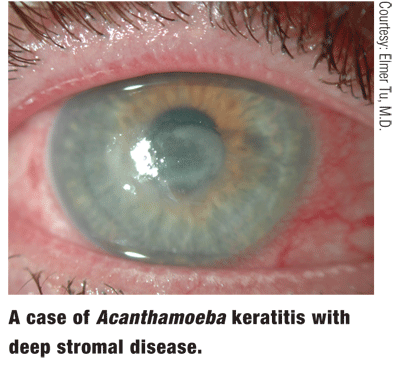 Q: Whats going on with our lens-wearing patients and multipurpose solutions? More specifically, why are there increasing reports of Acanthamoeba keratitis (AK) in contact lens wearers?
Q: Whats going on with our lens-wearing patients and multipurpose solutions? More specifically, why are there increasing reports of Acanthamoeba keratitis (AK) in contact lens wearers?
A: Rates of accurate diagnosis have increased thanks to advanced technology, such as confocal microscopy, that has allowed clinicians to better see and understand the presentation of AK.1 Confocal microscopy has greatly influenced the ability to detect cases of Acanthamoeba keratitis, says Elmer Tu, M.D., director of the Cornea and External Disease Service at the University of Illinois Eye and Ear Infirmary.
But, imaging is not the only method of diagnosis. Some [practitioners] will rely more on imaging and others on microbiologic evidence, but many will rely on clinical appearance, Dr. Tu says. Also, clinical suspicion is usually higher in endemic areas, and the health-care infrastructure may be more aware of Acanthamoeba as a possibilityleading to earlier referrals for diagnosis.
Certainly with any apparent increase in disease incidence, the first question to ask is whether there has been a change in diagnostic methodologies, adds Charlotte Joslin, O.D., also of the
 Dr. Joslin and colleagues initially thought this might account for an increase in cases in the
Dr. Joslin and colleagues initially thought this might account for an increase in cases in the
Links between specific solutions and infections have been noted. AMOs Complete MoisturePlus Multipurpose Solution was pulled from the shelves in May due to a strong association with Acanthamoeba keratitis, although there was no concern of product contamination.3-6 Of 46 patients diagnosed with AK since 2005, 21 used Complete MoisturePlus.5 AMO recalled the solution immediately.
Although a strong association between Advanced Medical Optics Complete MoisturePlus Multipurpose Solution and Acanthamoeba keratitis exists, nearly 40% of AK cases were not using this solution, which suggests that other factors may be contributory, Dr. Joslin says. Multipurpose solutions in general are not very effective against Acanthamoeba, even in the laboratory under the best-case testing scenarios.
Compliance with lens-care regimens remains a major factor in cases of Acanthamoeba infection. Drs. Joslin and Tu and their colleagues found that patients who re-used or topped off the solution in their lens cases more than six times per month were nearly twice as likely to be infected with AK as those who did so less often.3,4 Unfortunately, patient compliance has always been poor, and since it is a learned behavior, it probably is not something that will change overnightor even over a short couple-year period, Dr. Joslin says.
But, while compliance may play a role, it may be related to the fact that there is an increase in the overall load of organisms in the water supply. So, with a higher number of microbial organisms, poor compliance is more likely to suddenly have an effect, Dr. Joslin says.
1. Awwad ST, Petrol WM, McCulley JP, Cavanaugh HD. Updates in Acanthamoeba keratitis. Eye Contact Lens 2007 Jan;33(1):1-8.
2. Joslin, CE, Tu EY, McMahon TT, et al. Epidemiological characteristics of a Chicago-area Acanthamoeba keratitis outbreak. Am J Ophthalmol 2006 Aug;142(2):212-217.
3. Joslin, CE, Tu EY, Shoff ME, et al. The association of contact lens solution use and Acanthamoeba keratitis. Am J Ophthalmol 2007 Aug;144(2):169-180.
4. AK outbreak: Lens solution is but one factor. Rev Optom 2007 July;144(7):8.
5. Advanced Medical Optics. AMO announces voluntary recall of Complete MoisturePlus Multipurpose Solution. Press Release. 2007 May 25.
6. Advanced Medical Optics. Urgent medical device recall notice: information for eye-care professionals. 2007 May 29.

